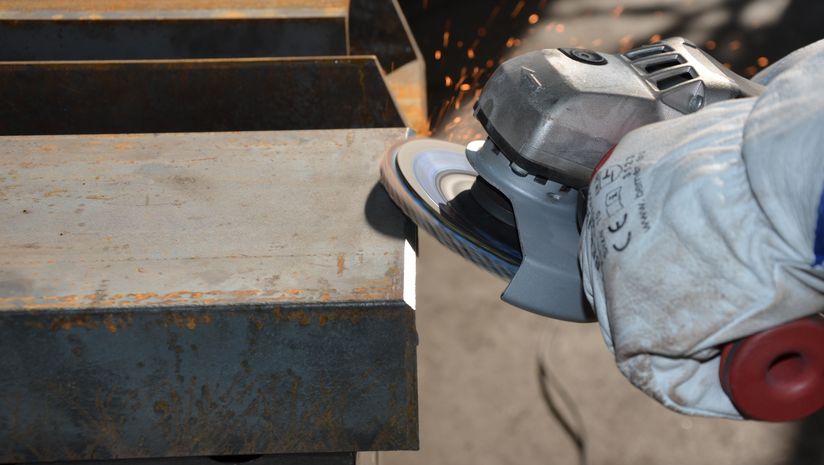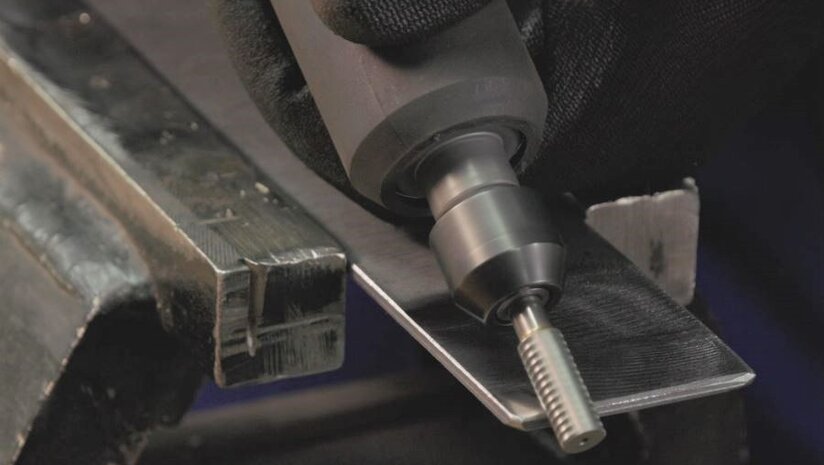
Beveling
If two workpieces are to be welded together, the edge of the workpieces must first be broken by a beveled surface. This is done by machining. The result is a chamfer, also known as a bevel.
What is beveling and
why is it important?
If two workpieces are to be welded together, the edge of the workpieces must first be broken by a beveled surface. This is done by machining. Or in other words, a space is created to accommodate the individual welding layers through which the workpieces are joined together. The bevel can have different shapes. The V-joint, the double V-joint, and the Y-joint are the most common shapes.
Which tool is used for beveling?
The position of the weld, the material of the workpiece, and the types of drives available - the choice of the right tool depends on various factors.
If an angle grinder is available, the beveling can be done with sulfur- and iron-free Osborn flap discs. Flap discs with a conical or straight shape are available. The angle on the workpiece determines the shape of the flap wheel.
If a workpiece made of non-ferrous metal is to be beveled, we recommend an abrasive cloth with a cooling bond as it reduces blue tarnish.

Pictured: Beveling with an Osborn flap disc.
If a straight grinder or air grinder is available, chamfering can be done with carbide burrs. The milling head is made of tungsten carbide-cobalt, the shank of tool steel. Different head shapes and toothings ensure that there is the right solution for every application.
For chamfering, burrs with cross serration (Z6) are the best choice. It ensures high stock removal in a short time. If the surface quality is important, a single tooth (Z3) is recommended. In the shipyard sector, the special shipyard toothing is often used. Compared to the Z6 toothing, it has a 30% higher material removal rate.

Camfering with a carbide burr.
Products for
Beveling.

Orange Tripoli Bar Cut/Color Compound
A full range of solid polishing compounds that can be used individually or in combination to achieve a desired result. All compounds are supplied in many variations and sizes for manual and robotic operations. There is no one size fits all, Osborn prides itself on recommending the best, most efficient solution for every application.

Epoxy Flap Wheels
Coated abrasive sheets are arranged in an epoxy bonded core, making an evenly distributed and quieter efficient polishing tool. This versatile wheel is available in multiple grit types and sizes and can be adapted to fit the application. Round parts, flat parts, edges and contours benefit from this product with its ability to continually produce consistent and repeatable results. Effective for applications with narrow face widths.

Non-Woven Flap Brush
Flexible, conformable wheels that apply uniform satin finishes. The density is dictated by how many flaps are wound around the core, therefore, a high-density for the firm face when working on a flat surface and a medium density for a softer, flexible face when the part is irregular in shape.

Non-woven Convolute Wheel
Non-woven abrasive web is wound around a core and specially treated, resulting in a consistent hardness and level of abrasion over the life of the product. This convolute product is perfect for light deburring. An arrow indicates the direction in which the wheels must be used. Blend and Finish wheels have an open mesh construction that is ideal for cleaning prior to coating applications.

Conventional Non-Woven Abrasive Disc
Non-woven wheels ideal for cleaning and finishing parts when using portable tools to get down into an area such as a rotary polisher and high speed grinders or stacked together on a shaft where flexibility is required by the operation
Flex Brush
An open mesh construction makes them ideal for applying finishes. Blending Stainless Steel surfaces to a #4 RMS finish is one the most common applicaitons
Garnet Abrasive Wheel
The Garnet Abrasive Wheel is a convolute wheel built by winding layers of a non-woven abrasive around a round core. The abrasive material is created by extruding fiber strands, resin and garnet mineral. With the softer organic minerals, garnet is a good match for woodworking applications, because it produces finer finishes than synthetic minerals. Ideal for the removal of mill/knife marks and chatter. Operating pressure and speeds are low to prevent burning.

White Bar Cut/Color Compound
A full range of solid polishing compounds that can be used individually or in combination to achieve a desired result. All compounds are supplied in many variations and sizes for manual and robotic operations. There is no one size fits all, Osborn prides itself on recommending the best, most efficient solution for every application.

Red Liquid High Color Compound
A full range of liquid polishing compounds that can be used individually or in combination to achieve a desired result. Liquid compounds are supplied in many variations of drums, totes, vats and gallon pails for manual and robotic operations. There is no one size fits all, Osborn prides itself on recommending the best, most efficient solution for every application.

Gray Liquid Cut Compound
A full range of liquid polishing compounds that can be used individually or in combination to achieve a desired result. Liquid compounds are supplied in many variations of drums, totes, vats and gallon pails for manual and robotic operations. There is no one size fits all, Osborn prides itself on recommending the best, most efficient solution for every application.

Green Liquid Color Compound
A full range of liquid polishing compounds that can be used individually or in combination to achieve a desired result. Liquid compounds are supplied in many variations of drums, totes, vats and gallon pails for manual and robotic operations. There is no one size fits all, Osborn prides itself on recommending the best, most efficient solution for every application.

Tripoli Orange Liquid Cut/Color Compound
A full range of liquid polishing compounds that can be used individually or in combination to achieve a desired result. Liquid compounds are supplied in many variations of drums, totes, vats and gallon pails for manual and robotic operations. There is no one size fits all, Osborn prides itself on recommending the best, most efficient solution for every application.